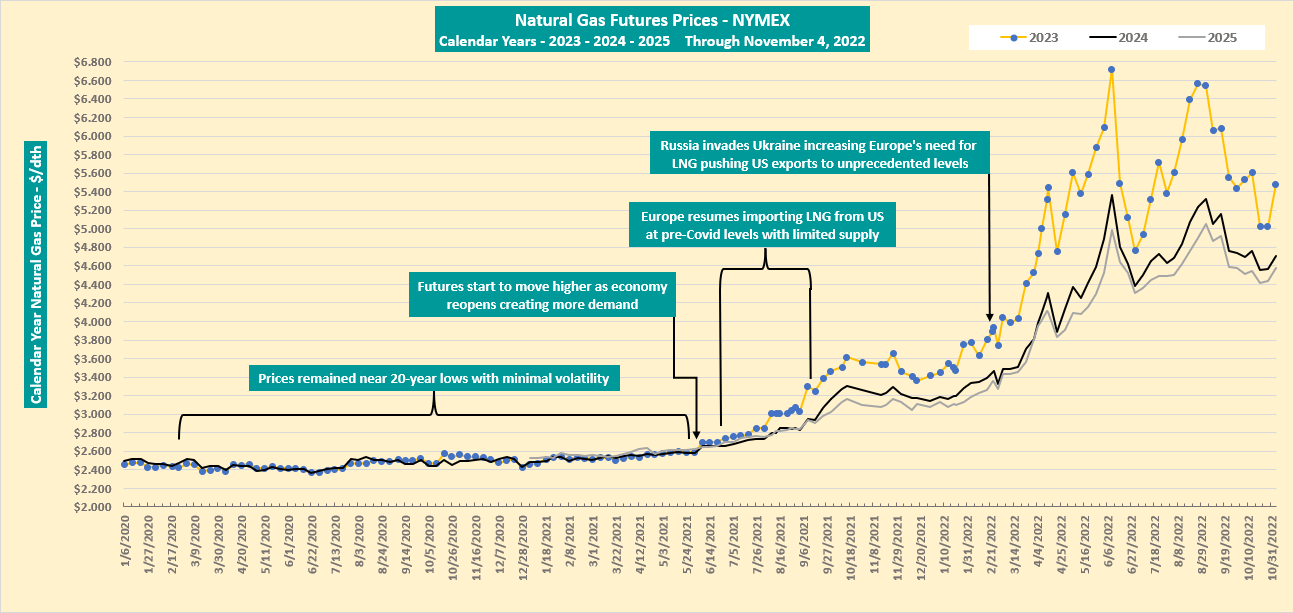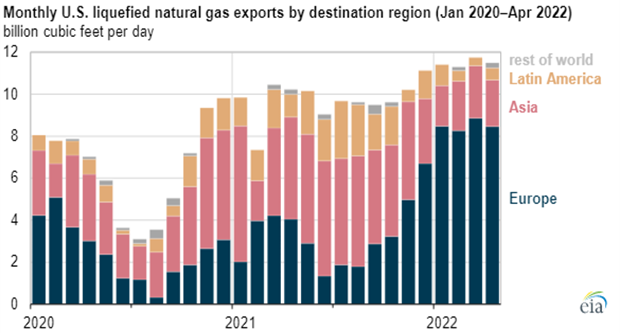
Dileep Prabhakar
Regional Sales Director
Freedom Energy
At the beginning of 2020, natural gas was plentiful and readily available. Even in New England, where pipeline constraints push natural gas and electricity markets higher, the region could keep those risks primarily in check due to ample supply, masking constraints to get gas into the region.
In March 2020, COVID-19 brought the world to a standstill. Natural gas hit lows not seen in 20 years, and demand came to a screeching halt. Supply dried up as demand waned, and many natural gas drillers and banks suffered tremendous losses. Per the chart below (see Figure 1), natural gas futures and, thus, electricity futures stayed low with little volatility through 2020 into 2021.

Figure 1
As COVID-19 re-openings began in early 2021, demand for natural gas increased, as did futures in the US. Also, reopening Europe started importing LNG (Liquified Natural Gas) via tanker from our Gulf Coast. Quickly exports reached pre-COVID-19 levels, pushing prices up as supply did not follow.
When Russia invaded Ukraine in early 2022, it pushed US Exports to levels never seen before in continental Europe (see Figure 2). Figure 2 also shows exports for the first four months of 2022 to Europe more than doubled from 2021.

Figure 2
The Freeport export terminal in Texas had a fire in June 2022 and has been closed since, limiting exports. This has led to more supplies staying domestic, helping limit price runups and allowing natural gas storage to align with previous years. The LNG site plans to start resuming exports soon, which could create more surges in pricing this winter.
While US exports soared, supply, per Figure 3, needed to catch up with the new demands. Even with record profits in 2022, Drillers are still recovering from the 2020 COVID-19 crash. Borrowing costs being higher now and banks still being skittish from the last crash have led to minimal supply increases.

Figure 3
Assuming New England will not be able to get pipeline infrastructure built and continues to be vulnerable to LNG shipment costs, what can the region do to lessen our reliance on natural gas?
Certainly not an easy solution nor a one size fits all solution, but here are some measures I believe can help in both the short and long term:
- Transition to nuclear power. Nuclear Power can produce a lot of electricity by splitting atoms (fission) with no carbon emissions and significantly reduce the region’s natural gas reliance. Older nuclear plants have closed in the region, and the output has been replaced with, for the most part, natural gas plants. Newer nuclear technology (referred to as 4th generation) in development is more efficient in reducing waste through reprocessing and shortens the radioactivity of the spent fuel. In addition, these smaller reactors are all self-contained and portable. This portability will help in emergencies and can easily connect to the grid in old coal plant locations. These plants are still decades away but should be an important part of our carbon-free future and will need to gain more public acceptance.
- Continue development of renewable energy resources. Hydrogen, solar, and wind must become more mainstream on a macro and end-user level. Volatility in the natural gas markets can speed up this process and helps society in trying to get to net zero. Environmental issues still need to be addressed, such as broken wind turbine blades (currently a big recycling problem) and fully used solar panels that can’t be reprocessed today.
- Limit consumption during times of peak usage through demand response. Battery Storage is a great way to achieve this without clients having to shut down equipment. This benefits grid resiliency limiting stress on the power lines and helping alleviate potential brownouts. The Southern New England States have great incentives for this.
- Invest in the grid and powerlines. The PowerGrid is outdated and not set up for the renewable future, let alone the current infrastructure. As we move to the electrification of vehicles, the grid nationwide will need to be upgraded and secured to handle the changing infrastructure. Yes, there will be billions in infrastructure costs associated with these upgrades, but can our economy in today’s world withstand grid disruptions? The Federal Government in the last month just approved $13B in financing to modernize the grid.
- Convert to heat pumps at both the commercial and residential levels. Heat pumps are a great way to control the climate in winter and summer. The name is a misnomer because they can also cool spaces with a reversing valve. Heat pumps efficiently gather and move heat with no fossil fuels and limited electricity usage and reduce the demand for both natural gas and oil as heating sources. The Inflation Reduction Act has created tremendous subsidies to convert to Heat Pumps.
All the above enhances the desire to move away from fossil fuels with the goal of carbon neutrality. It is a slow process, and there is no single solution to our region’s dependence on natural gas. This process of being less reliant on natural gas should have started a decade ago. A powerful breakthrough in Nuclear Fusion happened this week. Fusion can potentially eliminate all reliance on fossil fuels with very limited and shorter radioactive half-life of nuclear waste compared to fission. If this is the beginning of a big breakthrough in Fusion, it’s still many years away from implementation.
The region (and country) can’t wait for Fusion. We must move forward now with other measures to get to carbon neutrality. We will still be vulnerable to price spikes and natural gas shortages for several years, even as we try to shift away from this reliance and address critical issues like climate change.
Source: US. Energy Information Administration







Connect With Us